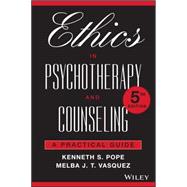The ethics book no psychology student or professional should be without
Thoroughly updated and expanded to include recent research findings, landmark legal decisions, the Hoffman Investigation Report, and changes in the ethical guidelines of the American Psychological Association and the Canadian Psychological Association, the new 5th edition of Ethics in Psychotherapy and Counseling covers the latest developments in ethical thinking, standards, and practice. You'll learn how to strengthen your ethical awareness, judgement, and decision-making.
Distinguished Emeritus Professor Don Meichenbaum described the 5th edition as 'a MUST READ book for both beginning and seasoned clinicians' and Professor David H. Barlow wrote, 'A stunningly good book. . . . If there is only one book you buy on ethics, this is the one.'
- Covers the many changes and challenges brought about by new technology, EHRs, videoconferencing, and texting, as well as practicing across state and provincial borders
- Discusses moral distress and moral courage
- Includes 5 chapters on different aspects of critical thinking about ethical challenges, including a chapter on 'Ethics Placebos, Cons, and Creative Cheating: A User's Guide'
- Deals with complex issue of culture, race, religion, sexual identity, sexual orientation, and politics
- Provides steps to strengthen ethics in organizations
- Offers guidance on responding to ethics, licensing, and malpractice complaints—not to imply that you'll need to after reading this book!









